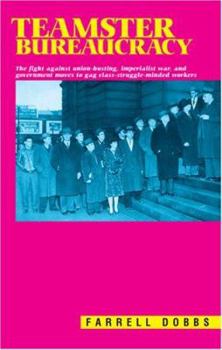Teamster Bureaucracy
How the class-struggle Teamsters leadership in the Upper Midwest organized to fight union busting, racism, and colonial oppression, as they opposed the mobilization of labor behind U.S. imperialist... This description may be from another edition of this product.
Format:Paperback
Language:English
ISBN:0873488636
ISBN13:9780873488631
Release Date:August 2002
Publisher:Pathfinder Press (WA)
Length:304 Pages
Customer Reviews
3 ratings
This book should be in every worker's library
Published by Thriftbooks.com User , 22 years ago
This is the fourth in the fascinating series of books on working class struggles in the 1930s, centering on the strikes and organizing by drivers and warehouse workers in the Midwestern states. Farrell Dobbs was a young worker in the Minneapolis coal yards who quickly became a leader of these strikes and organizing campaigns, as well as a member and then leader of the Socialist Workers Party. The first three volumes (Teamster Rebellion, Teamster Power, Teamster Politics-- don't miss them!) take up the important strikes in Minneapolis in 1934, the subsequent over-the-road organizing campaign throughout the upper Midwest, and the vital and complex political challenges militant workers took on in confronting the employers, their government, cops and finks, and reactionary, class-collaborationist trade union officials. Teamster Bureaucracy draws some of the broadest lessons for working class fighters from those years of struggle. Facing the intense political pressure of the opening years of WWII, the Stalin-Hitler pact, frame-ups by the FBI, the drive by Teamsters international president Daniel Tobin (aiding and aided by the Roosevelt administration) to crack down on militant local unions -- this book is full or rich experiences we can learn from today. It should be in every workers library!
how a fighting union was housbroken
Published by Thriftbooks.com User , 22 years ago
The major industrial unions rose from almost nothing to massive powerful organizations in the mid to late 1930s. They were social movements in the broadest sense. They led powerful strike mobilizations, galvanizing the hopes of not merely their own members, but other workers, the unemployed, family farmers, and others. By the 1950s, U.S. union structures had become a prop of capitalism, both domestically and internationally, ruled by officialdom as corrupt and disloyal to workers as can be found on any corporate board. How did the fighting unions become their opposite? Farrell Dobbs, a Minneapolis Teamster and leader of the famed 1934 Minneapolis general strike, and later of the Socialist Workers Party, describes how the militancy of his union was confronted, and smashed, in the prelude and opening of World War II. He also explains the lessons to be learned by today?s militant workers.
Workers against World War II
Published by Thriftbooks.com User , 22 years ago
This book, which is the third and last in a series by the same author, tells the riveting story of a group of workers in Minneapolis organized into a local of the Teamsters Union who were victimized for opposing the entrance of the US into World War II. It shows quite convincingly how World War II, contrary to the recent hoopla over Tom Hanks and Saving Private Ryan, was anything but "the good war." Author Farrell Dobbs was an elected local Teamsters leader, who had helped spearhead organizing drives which built the union into a major power in the midwest during the 1930s. Dobbs was also a leader of the Socialist Workers Party, which gained a lot of influence in the labor movement in Minneapolis; and which openly opposed the US entry into World War II. Dobbs and his fellow Teamster and Socialist activists had to fight the combined might of the national Teamster bureaucrats, the local trucking bosses and the Roosevelt Administration, who succeeded in putting Dobbs and others on trial for sedition. The defendants were the first to be tried under the 1940 Smith Act, later used widely against members of the Communist Party. The defendants were also charged with violating an old law passed in 1861 to target the Confederacy, which had never been used. Though the defendants were convicted and spent time in federal prison, the book shows how they put up an excellent public defense and won many supporters. Especially in conjunction with Dobbs' two earlier installments in the series, this is book well worth reading.





